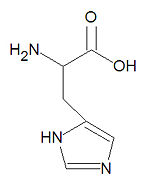Histidine: Difference between revisions
Jump to navigation
Jump to search

imported>David E. Volk (stub and structure again) |
mNo edit summary |
||
| (One intermediate revision by one other user not shown) | |||
| Line 1: | Line 1: | ||
{{subpages}} | {{subpages}} | ||
{{Image|Histidine stick figure.jpg|right|150px|'''Histidine''', a common amino acid.}} | |||
'''Histidine''', abbreviated '''His''' or '''H''', is one of the twenty common <math>\alpha</math>-[[amino acid]]s used by living organisms to build [[protein]]s. It is one of the four [[aromatic]] amino acids along with [[phenylalanine]], [[tyrosine]] and [[tryptophan]]. At physioligical pH, histidine is usually protonated and is found mostly on the surface of proteins. | '''Histidine''', abbreviated '''His''' or '''H''', is one of the twenty common <math>\alpha</math>-[[amino acid]]s used by living organisms to build [[protein]]s. It is one of the four [[aromatic]] amino acids along with [[phenylalanine]], [[tyrosine]] and [[tryptophan]]. At physioligical pH, histidine is usually protonated and is found mostly on the surface of proteins.[[Category:Suggestion Bot Tag]] | ||
Latest revision as of 06:00, 28 August 2024
Histidine, abbreviated His or H, is one of the twenty common -amino acids used by living organisms to build proteins. It is one of the four aromatic amino acids along with phenylalanine, tyrosine and tryptophan. At physioligical pH, histidine is usually protonated and is found mostly on the surface of proteins.

